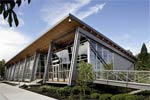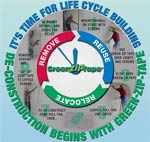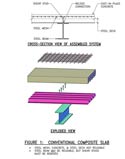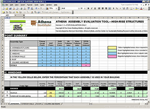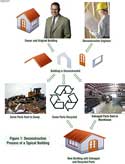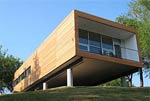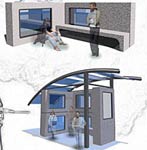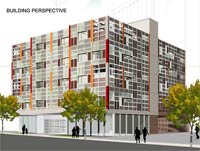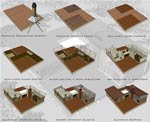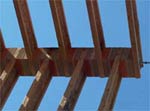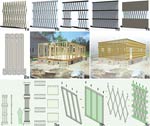Contact Pacific Southwest Waste Program
Pacific Southwest, Region 9
Serving: Arizona, California, Hawaii, Nevada, Pacific Islands, Tribal Nations
Lifecycle Building Challenge Winners
 Innovative Green Building Competition
Innovative Green Building Competition
The U.S. Environmental Protection Agency is recognizing cutting-edge green building ideas to reduce the environmental and energy impacts of buildings. EPA Assistant Administrator Susan Bodine, American Institute of Architects President RK Stewart, and Building Materials Reuse Association President Brad Guy will recognize award winners of the Lifecycle Building Challenge ![]() competition in a video awards ceremony on September 20, 2007, at the West Coast Green Conference
competition in a video awards ceremony on September 20, 2007, at the West Coast Green Conference ![]() in San Francisco, California.
in San Francisco, California.
Background
The competition, which is in its first year, collected ideas from students and professionals on designing buildings for adaptation, deconstruction, and material reuse. Lifecycle building incorporates innovative strategies for creating buildings that can be easily disassembled, allowing their components to be reused rather than landfilled to conserve resources and energy.
The project supports U.S. EPA’s Green Building program, Resource Conservation Challenge and the Agency’s Memorandum of Understanding on green building and sustainable development with the American Institute of Architects.
Reducing Construction and Demolition Debris and Greenhouse Gas Emissions
Ideas from the design contest will jumpstart the building industry to help reuse more of the 100 million tons of building-related construction and demolition debris sent each year to landfills in the United States. Reusing building components also reduces the energy and greenhouse gases emissions associated with producing and transporting building materials. Construction and demolition debris comprises about 40 percent of the solid waste stream. To reverse this trend, a lifecycle building approach plans for deconstruction and fosters local material reuse.
Between the years 2000 and 2030, projections indicate that 27 percent of existing buildings will be replaced, and 50 percent of the total building stock will be constructed. Consequently, it is critical to focus on conserving building materials and energy by integrating lifecycle building practices into standard building practices and policies.
The competition builds on a U.S. EPA Design for Deconstruction grant to Chartwell School ![]() , a projected U.S. Green Building Council Leadership in Energy and Environmental Design (LEED) Platinum green building project in Seaside, California.
, a projected U.S. Green Building Council Leadership in Energy and Environmental Design (LEED) Platinum green building project in Seaside, California.
Partners and Sponsors
The competition partners are the U.S. Environmental Protection Agency, the American Institute of Architects, the Building Materials Reuse Association, and West Coast Green. The Challenge sponsor, Green Building Blocks, is providing cash awards to the student winners and Green Building in Alameda County sponsored the deconstructable award objects made from used building materials.
The competition website with all entries is at Lifecycle Building Challenge Awards Ceremony.
Winning Entries
There are three categories: Building, Component, and Service and each category has Student, Professional – Built, and Professional – Unbuilt winners. A People’s Choice Award based on online voting was also recognized.
Building: Professional - Built
Winner: Pavilion in the Park ![]()
Building that separates into four modules and can be moved by truck
David Miller (dmiller@millerhull.com)
architectural designer at The Miller|Hull Partnership
Seattle WA
(206) 682-6837
(attending conference)
Bill Franklin (BFranklin@millerhull.com)
(206)919-5830
The 11,100 square foot Pavilion in the Park’s entire structure is designed for future transportation, reassembly and reuse in a new location. The building’s parts separate at three integrated joints to break into four separate modules that can be moved on trucks by surface street. The building sits lightly on the land atop short concrete piers allowing the grade and vegetation to run uninterrupted beneath. Gangway ramps with integrated hinged joints, allow the ramps to adapt to the topography of future locations.
Building: Professional - Unbuilt
Winner: GreenMobile Factory-built ![]()
Housing Units for SE USA Adaptable mobile home unit for disaster relief and permanent use
Michael Berk (mberk@caad.msstate.edu)
Mississippi State, MS
Professor at Mississippi State University School of Architecture ![]()
(662) 325-2202
(415) 626-8000
The GreenMobile ™ envisions affordable, factory-built energy efficient mobile home units that meet International Residential Code for housing with structurally-sound foundations, demountable for easy relocation, and can function in a place with a limited infrastructure or no utility grid in-place. They can be used for immediate disaster relief housing (including first responders) and later converted to permanent housing. This project will incorporate systematic strategies for growth and change as family structures also grow and change. "Pre-fabricated plug-in" rooms, plug-in porches, and surface mounted wiring are also featured in this design.
Building: Student
Winners
The groHome Open source housing modules to meet changing family and community needs
Adam Fenner (adamfenner@gmail.com), Jason Bond, Thomas Gerhardt, Josh Canez, Nick Schaider ![]()
A team of students at Texas A&M University, 2007 Solar Decathlon Team
College Station, TX
(214) 534-0028
The open source concept used in the software community is adapted in this entry to develop open source building systems allowing anyone to design and incorporate elements into the building system if grid protocols and standard joint connections are used. Using a library of pre-manufactured components brought to a site and assembled efficiently, the structure is designed with a specialized bolted connector joints that allows for components to be unplugged easily and without damage. Radio Frequency Identification Tags (RFID) can be embedded to take inventory and check the history of components. The project even includes a community building game, Utopia 2.0, to allow neighbors to swap building modules as family and community needs change.
People's Choice Award
Winner: Sustainability by Design
Deconstruction and Adaptive Reuse Comprehensive 99% reuse and recycling construction project
Mitch Boucher, Chuck Otto (chuck.otto@haworth.com) ![]()
Haworth, Inc.
(616) 393-3856
When Haworth, a global designer and manufacturer of adaptable workspace environments, planned major renovations on its headquarters, the company set a goal to recycle or salvage up to 75 percent of the materials. The project diverted more than 99 percent of construction materials through reuse and recycling: 321 tons of steel were recycled; 75 workstations were donated; and even the door locksets were removed intact and reused in other facilities. More than 58,000 tons of carpet tiles were removed for re-installation, donation to local schools, or recycling.
Component: Professional - Built
Winner: Green-Zip-TapeTM Demountable Tape
Drywall tape attachment system to support easy deconstruction and reuse ![]()
Frank Little
Founder of Tax Advantage Design
Magnolia, TX
(281) 356-2300
(281) 703-2300
This patented demountable tape provides an alternative method for hanging sheetrock for later de-construction and reuse. Drywall has traditionally been a barrier to gaining easy access to structural components of the building for repair or reuse. This tape and associated screw connectors allow drywall to be easily removed and replaces the traditional nailing mechanism, which can damage the drywall and inhibit reuse
Component: Professional - Unbuilt
Winner: Deconstructable and Reusable Composite Slab
Reusable structural floor system
Mark D. Webster (mdwebster@sgh.com), Dirk M. Kestner, James C. Parker, Matthew H. Johnson ![]()
Structural Engineers Simpson Gumpertz & Heger
Waltham, MA
(781) 907-9369
(781) 907-9392
The composite component system uses specialized bolts, serrated clamps, and cast-in channels to create a more easily disassembled system, allowing reuse of the composite slab. A serious problem with the conventional composite slab is that it is a "throw-away" system; most of the parts are completely non-reusable at the end of the building's life. The team developed a composite slab system that maintains the efficiency benefits offered by composite action, while adding near 100 percent reusability. This structure allows the slab and beam to work together to resist bending due to floor loads. The size of the steel beam can be reduced by over 30% providing both economic and environmental benefits.
Component: Student
Winner: Guidelines for Building with Reusable Materials ![]()
Creative designs from reused building materials collected regionally
Aaron Tvrdy (aaron.tvrdy@gmail.com)
University of Nebraska
Lincoln, NE
(402) 440-3914
This project foresees waste materials gathered in bulk, refurbished, and stored in regional design centers where designers can create components out of the former waste. One example uses discarded railroad track and ties to create a superstructure for a wood pallet wall system. With a creative design approach, reclaimed material kits can be used to create attractive components that can either celebrate or conceal their original identity.
Service: Professional - Built
Winner: ATHENA Assembly Evaluation Tool
Software on the lifecycle environmental impacts of building assemblies ![]()
Wayne Trusty
ATHENA Institute
Kutztown, PA
Mike Gehrig (mgehrig@webershandwick.com)
(312) 988-2065
(773) 610-7305
Life Cycle Analysis (LCA) is one tool for determining the environmental impacts of various building materials through all phases of its life, from extraction through use and disposal. The ATHENA software tool adopts LCA methodology to measure the climate-changing potential and other environmental impacts of more than 400 common building assemblies. A generic version will be made available, free of charge, to the entire sustainable construction community.
Service: Student
Winner: Deconstruction Engineer
Proposed new profession to support building deconstruction ![]()
Keith Cullum (keithecullum@gmail.com), Paul Sargent
California Polytechnic State University
Yorba Linda, CA
(714) 932-8729
The project proposes a new degree program and profession: the deconstruction engineer. These professionals would consult throughout a building’s lifecycle to ensure that adaptation and deconstruction occur in the most effective way. During the first stages of planning a structure, the engineer would offer design suggestions to anticipate efficient deconstruction and at the end of a building’s life, the deconstruction engineer would evaluate and assess safe reverse construction procedures for salvaging materials.
Honorable Mention
Honorable mention: Modular 3 - Flexible single family home with movable walls
Dan Rockhill (rockhill@sunflower.com)
Lawrence, KS
Studio 804¸ University of Kansas
(785) 393-0747
www.rockhillandassociates.com ![]()
www.studio804.com ![]()
This two bedrooms and one bath residence utilizes all of the 1,200 square foot of living space that is composed of six modules. The proportions of Modular 3 have been tailored to the dimensions of a standard city lot, and a raised pier foundation allows for low-impact implementation in nearly any single-family residential context. A movable storage wall permits splitting an area such as a single bedroom into a separate office and storage space at the homeowner's whim.
Honorable mention: Re-use of Cleveland Iconographic Structure - Transit stations and street furniture made from a building façade
Dru McKeown (dru.mcq@gmail.com)
Lakewood, OH
(216) 849-5304
www.toistudio.com ![]()
Instead of creating new building systems, designs for bus and light rail transit stations and street furniture were created out of the façade of a building slated for demolition. The project recaptures the materials and embodied energy that were spent creating the initial structure. The entrant calculated that the average building embodied energy is equivalent 10 – 15 gallons of gasoline /square foot and that materials in an average American home have embodied energy equal to 29.25 autos weighing 1.5 tons.
Honorable mention: Transformative Multi-family Housing ![]() - Shape shifting residential and office space
- Shape shifting residential and office space
Koji Saida (koji@saidasullivan.com), Mimi Sullivan, Hyun Joo Choi, Keiko Ito
Architect at Saida + Sullivan Design Partners
San Francisco, CA
(415) 777-0991 ext.112
(415) 794-9801
The transformative multi-family housing is a mixed use project with 12 residential units and one retail space on the ground level. By standardizing all the building components and using a simple connection system, the entire building's components can be easily deconstructed, reused and recycled. Housing which standardizes all the building components using a simple connection system. By exchanging some standardized wall panels, a 2 bedroom unit transforms into a 3 bedroom unit and by removing all non bearing walls, the three residential units which are grouped as typical can be transformed into an office use.
Honorable mention: Nine Components to Residential Architecture ![]() - Flexible modular housing with steel bearing pin foundation
- Flexible modular housing with steel bearing pin foundation
Anthony Piede (tony.piede@gatech.edu)
Student at Georgia Tech
Atlanta, GA
(770) 354-9759
An integrated system that simplifies design, construction, and disassembly with a pieramid foundation raised on steel bearing pins to allow easy assembly and disassembly without poured concrete. Other featured components include modular decking frame, reclaimed wood decking, flitch beams and columns with simple screw and bolt connections, prefab structurally insulated panels, insulated glass units with optimal thermal performance, and snap-on panel aluminum roofing.
Honorable mention: Community Revival Shelter ![]() - Innovative structures for community rebuilding in disaster areas
- Innovative structures for community rebuilding in disaster areas
Greta Modesitt (gkm9s@virginia.edu)
Student at University of Virginia
New York, NY
(770) 833-7259
The concept creates transitional community spaces to support cooperation amongst the inhabitants while they renovate their post-disaster neighborhoods. An umbrella superstructure protects rebuilders from the elements while temporary steel web, cardboard, and fabric structures designed for off the grid living are erected and used until rebuilding of permanent structures is complete.
Honorable mention: Joist Lock - Rigid wood connecting system alternative to conventional framing
David Wilson (dwilson@avavasystems.com) and Michael Kozel
Engineer at AVAVA Systems¸ LLC ![]()
Berkeley, CA
The joist-lock component is a strong, reusable alternative to conventional wood framing. This patent-pending device connects manufactured wood I-joists intersecting from two different planes and locks, creating rigid connection at the intersection. The rigid connection creates a force-resistant frame out of the wood shell of a building, eliminating the need for braces or shear walls to support the shell against wind and earthquake forces. The joist lock creates a rigid tube that can span from end to end, eliminating the need for continuous foundations used in traditional construction.
Honorable mention: Expansive Panel System - Reusable, waste reducing alternative to traditional wood framing
Sean Dorsy
Expand-a-panel.com ![]()
Catholic University of America
Washington DC
(202) 246-4633
Inspired from the efficiency of pizza boxes, the Expansive Panel System [EPS] is an alternative to traditional wood framing. EPA uses Digital Fabrication and Computer Numerical Controlled machinery to fabricate with minimal material waste while allowing for a simple assembly using precise components. The EPS has a "zig-zagging" alternating pattern that allows panels to expand from a single sheet of plywood without added fasteners to conserve reduces material, time, and money. A projection comparing the EPS to traditional light-frame construction found a cost savings of $597 and material weight reduction of 4,406 pounds. These components are also designed for disassembly and for reuse in future structures.
Honorable mention: Low-tech Pre-fabricated Structural Building System ![]() - Flexible, recyclable cardboard and foam dome structure
- Flexible, recyclable cardboard and foam dome structure
Siobhan Rockcastle, Cayley Lambur (cayley@gmail.com), Dana Cupkova-Myers, and Kevin Pratt
Cornell University
Ithaca, NY
(607) 351-4508
The flexible dome shaped system uses laser-cut recyclable cardboard, high-density polystyrene foam, and a waterproof fabric membrane option, which can be separated, readapted, and recycled as needed. The basic bracing structure can be sequentially erected very quickly: pre-fabricated cardboard bracing is folded along seams; waterproof glue with a catalytic release is applied to lower ridges of the bracing; hexagonal/triangular lightweight foam panels are then adhered; and a compressible foam rod is inserted between panels to eliminate the need for sealant.
Honorable mention: Light Switch/Geodesic Dome ![]() - Simple structures examining design for disassembly
- Simple structures examining design for disassembly
Thomas Hagerty (tomhagerty@hotmail.com)
Iowa State University
Muscatine, IA
(563) 260-6612
This submission examined the question: “Why aren’t buildings already designed to be disassembled?” A simple structure was made of light switch mounting brackets, an object from which many different structures could be built, and the project grew to include joint details, connection diagrams, and alternative spaces and elevations to support the concept of lifecycle building.
Honorable mention: The Nail Extractor ![]() - Nail and staple removal tool eases building disassembly
- Nail and staple removal tool eases building disassembly
Jeff Wagner (jeff@nailextractor.com)
The Nail Extractor
Charleston, SC
(843) 556-0455
These extracting pliers were invented to aid in building restoration and renovation by removing fasteners without bending or cutting the exposed materials. During a renovation or salvage project, the amount of fastener removal that is required can be extensive and time-consuming. Though the nail extractor was originally designed to pull brittle older nails, it can also remove modern-day pneumatic nails and staples, with their slender shanks and undersized heads. The tool allows for easy, single-handed operation, using jaws that exert increasing gripping pressure in proportion to the resistance encountered during extraction.
Honorable mention: Promoting Reuse of Building Materials While Protecting Public Health ![]() - Proposal to examine lead-paint building material reuse options
- Proposal to examine lead-paint building material reuse options
Jennifer Voichick (jvoichick@restoredane.org)
Habitat for Humanity of Dane County
Madison, WI
(608) 661-2813
www.restoredane.org
This project that explores options to divert building materials with potential lead-paint hazards from landfills in a manner that is both environmentally responsible and addresses public health concerns. Under Wisconsin state law, all items with paint or other coatings produced before 1978 are presumed to present lead hazards unless tested to prove otherwise. The proposal would identify alternatives to landfills that allow reuse of materials with lead-based coatings and address concerns about lead poisoning that could serve as a national model and other businesses promoting reuse of building materials.
Honorable mention: AHP-Based Selection Model for Best Sustainable Practices for Construction Projects ![]() - Model to train contractors on sustainable construction priorities
- Model to train contractors on sustainable construction priorities
Suhasini Hyderabad (suha@unm.edu)
Albuquerque, NM
University of New Mexico
(505) 353-1438
This Analytical Hierarchy Process (AHP) Model allows contractors to evaluate sustainable construction methods against a set of criteria to help educate contractors on sustainable construction practices and their potential benefits. Reusable concrete forms are evaluated in the model. Benefits to contractors using sustainable methods, include: savings on construction costs, increased competitiveness between contractors in sustainable construction, and reduced impact on the environment.
Honorable mention: Living Homes Studio ![]() - Sustainable building prototype to demonstrate new housing technologies
- Sustainable building prototype to demonstrate new housing technologies
Julie Phanstiel (juliephanstiel@yahoo.com)
Los Angeles, CA
Art Center College of Design
(323) 440-1852
The Living Homes Studio has designed and built a full scale architectural prototype demonstrating the use of new technologies in creating a sustainable living environment. This photovoltaic powered prototype integrates prefabricated components with passive heating, cooling, and air exchange systems to create a model for sustainable housing. Through the use of pre-fabricated components, design for disassembly, and sustainable systems the project creates a project sensitive to its users and the natural environment.
EPA Contacts
Timonie Hood (hood.timonie@epa.gov) (415) 972-3282
Saskia van Gendt (vangendt.saskia@epa.gov) (415) 947-4103

